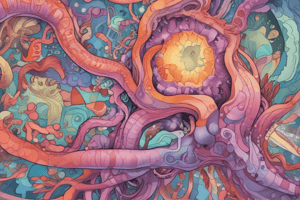Podcast
Questions and Answers
In chronic inflammation, which cellular infiltrate is most commonly observed?
In chronic inflammation, which cellular infiltrate is most commonly observed?
- Neutrophils
- Basophils
- Eosinophils
- Monocytes/macrophages and lymphocytes (correct)
Which of the following is NOT a typical characteristic of acute inflammation?
Which of the following is NOT a typical characteristic of acute inflammation?
- Fast onset
- Predominance of neutrophils
- Prominent local and systemic signs
- Significant fibrosis and angiogenesis (correct)
Long-term exposure to a stimulus is most likely to result in which type of inflammation?
Long-term exposure to a stimulus is most likely to result in which type of inflammation?
- Chronic inflammation (correct)
- Subacute inflammation
- Transient inflammation
- Acute inflammation
Which of the following is NOT considered a cardinal sign of acute inflammation?
Which of the following is NOT considered a cardinal sign of acute inflammation?
Increased hydrostatic pressure in blood vessels during acute inflammation directly leads to what event?
Increased hydrostatic pressure in blood vessels during acute inflammation directly leads to what event?
What is the primary effect of persistent vasodilation in the context of acute inflammation?
What is the primary effect of persistent vasodilation in the context of acute inflammation?
Endothelial cell contraction leads to increased vascular permeability by which mechanism?
Endothelial cell contraction leads to increased vascular permeability by which mechanism?
Which of the following scenarios would most likely lead to chronic inflammation rather than acute inflammation?
Which of the following scenarios would most likely lead to chronic inflammation rather than acute inflammation?
Which of the following is the MOST comprehensive definition of inflammation, incorporating its underlying purpose?
Which of the following is the MOST comprehensive definition of inflammation, incorporating its underlying purpose?
Consider a scenario where a patient presents with a localized inflammatory response following a minor skin abrasion. Which sequence of events BEST describes the formation of a cellular exudate at the site of injury?
Consider a scenario where a patient presents with a localized inflammatory response following a minor skin abrasion. Which sequence of events BEST describes the formation of a cellular exudate at the site of injury?
A researcher is investigating the effects of a novel anti-inflammatory compound. Which of the following mechanisms of action would BEST indicate the compound's potential to resolve acute inflammation?
A researcher is investigating the effects of a novel anti-inflammatory compound. Which of the following mechanisms of action would BEST indicate the compound's potential to resolve acute inflammation?
A patient has recurrent inflammation caused by exposure to an allergen. Which initial event is MOST likely responsible for triggering the inflammatory response?
A patient has recurrent inflammation caused by exposure to an allergen. Which initial event is MOST likely responsible for triggering the inflammatory response?
During phagocytosis, a macrophage engulfs a bacterium. Which process is MOST crucial for the intracellular killing of the ingested bacterium?
During phagocytosis, a macrophage engulfs a bacterium. Which process is MOST crucial for the intracellular killing of the ingested bacterium?
Which of the following best describes the role of histamine in the inflammatory response?
Which of the following best describes the role of histamine in the inflammatory response?
Leukotrienes are known to perform which of the following functions during inflammation?
Leukotrienes are known to perform which of the following functions during inflammation?
How do chemokines contribute to the inflammatory response?
How do chemokines contribute to the inflammatory response?
What is the primary function of Tumor Necrosis Factor (TNF) in the context of inflammation?
What is the primary function of Tumor Necrosis Factor (TNF) in the context of inflammation?
Which of the following is a characteristic action of prostaglandins during inflammation?
Which of the following is a characteristic action of prostaglandins during inflammation?
How do osteoblasts modulate the inflammatory response?
How do osteoblasts modulate the inflammatory response?
Which of the following mediators is most directly involved in the recruitment of neutrophils to the site of inflammation?
Which of the following mediators is most directly involved in the recruitment of neutrophils to the site of inflammation?
What is the primary role of opsonization in the process of phagocytosis?
What is the primary role of opsonization in the process of phagocytosis?
Interleukins (IL-1, IL-6, IL-8) are primarily involved in which aspect of the inflammatory process?
Interleukins (IL-1, IL-6, IL-8) are primarily involved in which aspect of the inflammatory process?
In an inflamed tissue site, which of the following enzymes released by neutrophils and macrophages directly contributes to tissue breakdown?
In an inflamed tissue site, which of the following enzymes released by neutrophils and macrophages directly contributes to tissue breakdown?
What is the primary function of chemotaxis in the context of leucocyte recruitment during inflammation?
What is the primary function of chemotaxis in the context of leucocyte recruitment during inflammation?
Which of the following is NOT a typical outcome observed in patterns of acute inflammation?
Which of the following is NOT a typical outcome observed in patterns of acute inflammation?
Which of the following cell types is NOT a recognized source of endogenous chemical mediators involved in inflammation?
Which of the following cell types is NOT a recognized source of endogenous chemical mediators involved in inflammation?
What is the role of increased transcytosis in the context of inflammation?
What is the role of increased transcytosis in the context of inflammation?
Why is leakage from newly formed blood vessels a key characteristic of inflammation?
Why is leakage from newly formed blood vessels a key characteristic of inflammation?
Which of the following cell types is NOT known to produce cytokines during an inflammatory response?
Which of the following cell types is NOT known to produce cytokines during an inflammatory response?
Flashcards
Inflammation Definition
Inflammation Definition
Local tissue response to injury.
Inflammation Stimuli
Inflammation Stimuli
Microbial, immunological, physical, and chemical agents.
Inflammation: Friend or Foe?
Inflammation: Friend or Foe?
Defense mechanism that can sometimes cause damage.
Exudate Formation Significance
Exudate Formation Significance
Signup and view all the flashcards
Exudate Types
Exudate Types
Signup and view all the flashcards
Acute Inflammation
Acute Inflammation
Signup and view all the flashcards
Chronic Inflammation
Chronic Inflammation
Signup and view all the flashcards
Cellular Infiltrate in Acute Inflammation
Cellular Infiltrate in Acute Inflammation
Signup and view all the flashcards
Cellular Infiltrate in Chronic Inflammation
Cellular Infiltrate in Chronic Inflammation
Signup and view all the flashcards
Rubor (Redness)
Rubor (Redness)
Signup and view all the flashcards
Calor (Heat)
Calor (Heat)
Signup and view all the flashcards
Tumor (Swelling)
Tumor (Swelling)
Signup and view all the flashcards
Vascular Event in Acute Inflammation
Vascular Event in Acute Inflammation
Signup and view all the flashcards
Chemotaxis
Chemotaxis
Signup and view all the flashcards
Phagocytosis
Phagocytosis
Signup and view all the flashcards
PMNs
PMNs
Signup and view all the flashcards
Monocytes & Macrophages
Monocytes & Macrophages
Signup and view all the flashcards
Opsonisation
Opsonisation
Signup and view all the flashcards
Proteolytic Enzymes
Proteolytic Enzymes
Signup and view all the flashcards
Chemical Mediator
Chemical Mediator
Signup and view all the flashcards
Cytokines
Cytokines
Signup and view all the flashcards
Osteoblasts
Osteoblasts
Signup and view all the flashcards
Interleukins (IL-1, IL-6, IL-8)
Interleukins (IL-1, IL-6, IL-8)
Signup and view all the flashcards
Tumor Necrosis Factor (TNF)
Tumor Necrosis Factor (TNF)
Signup and view all the flashcards
Histamine
Histamine
Signup and view all the flashcards
Prostaglandins
Prostaglandins
Signup and view all the flashcards
Leukotrienes
Leukotrienes
Signup and view all the flashcards
Chemokines
Chemokines
Signup and view all the flashcards
Inflammation Mediators
Inflammation Mediators
Signup and view all the flashcards
Study Notes
- Intended learning outcomes include being able to describe the classical signs of acute inflammation, explain the significance of cellular and fluid exudate formation, discuss ways inflammation can be generated, explain phagocytosis and bacterial killing, and to recognize effects and action of chemical mediators
Inflammation Overview
- Inflammation can be both a friend and foe
- It's relevant to dentistry
Defining Inflammation
- Local response of tissue to injury
- Stimuli for inflammation can be microbial, immunological, physical or caused by chemical agents
Types of Inflammation
- Acute inflammation
- Chronic inflammation
Acute vs. Chronic Inflammation
- Acute onset is fast, chronic onset is slow
- Acute cellular infiltrate is mainly neutrophils, chronic involves monocytes, macrophages, and lymphocytes
- Acute tissue injury is mild and self-limited
- Acute inflammation has prominent local and systemic factors
- Cardinal signs present in acute inflammation, absent in chronic
- Acute stimulus short, chronic stimulus long acting
- Acute response clears stimulus, chronic response involves fibrosis and angiogenesis
Causes
- Infections can cause inflammation via bacteria, viruses, fungi and parasites
- Tissue necrosis from physical/chemical injuries and heart attacks
- Trauma can cause inflammation
- Foreign bodies like splinters, sutures, bones and fingernails lead to an inflammatory response
- Immune hypersensitivity reactions, triggered by environmental factors or autoimmune diseases cause inflammation
Cardinal Signs of Inflammation
- Rubor (redness)
- Calor (heat)
- Tumor(swelling)
- Dolor (pain)
- Loss of function
Vascular Events
- Persistent vasodilation
- There is an elevation of hydrostatic pressure
- Increase in vascular permeability
- Transudation of fluid into extracellular space
- Slowing or stasis of microcirculation.
Causes of Increased Vascular Permeability
- Endothelial cell contraction
- Endothelial injury may be direct or leukocyte induced
- Increased transcytosis fluid
- Leakage from new blood vessels
Cellular Events
- Leukocyte recruitment (chemotaxis)
- Phagocytosis of particles
Phagocytosis
- Two types of phagocytic cells exist
- Polymorphonuclear leukocytes (PMNs) are part of the early inflammatory response
- Monocytes and macrophages
- Opsonization is a marker by which neutrophils and macrophages release proteolytic enzymes
Patterns of Inflammation
- Serous
- Fibrinous
- Suppurative (purulent)
- Ulcerative
Chemical Mediators
- These are chemical messengers act on blood vessels, inflammatory cells to cause an inflammatory response
- Can be exogenous or endogenous
- Exogenous mediators are endotoxins
- Endogenous mediators can originate from plasma, leukocytes, endothelial cells, or fibroblasts
Cytokines
- These are chemical proteins produced by many cells e.g. PMN's, macrophages, B lymphocytes, epithelial cells, gingival fibroblasts and osteoblasts
- Mediate & regulate immune & inflammatory reactions
- Interleukins are pro-inflammatory & anti-inflammatory compounds, such as IL-1, IL-6 & IL-8
Histamine
- Vasoactive amine produced by mast cells
- Acts on blood vessels
- Cause dilation of arterioles & increased permeability
Prostaglandins
- Produced by mast cells, macrophages & endothelial cells
- These are lipid compounds
- Involved in vascular & systemic inflammation, cause vasodilation, fever and pain
Leukotrienes
- Produced by leucocytes and mast cells through lipoxygenase action
- Act as chemotactic agents for neutrophils
- Usually accompanied by histamine & prostaglandins
- Releases lysosomal enzymes
- Cause vasoconstriction
Chemokines
- Family of small proteins act as chemo-attractants for leukocytes and enhance chemotaxis
Studying That Suits You
Use AI to generate personalized quizzes and flashcards to suit your learning preferences.





